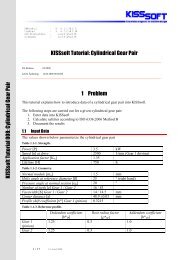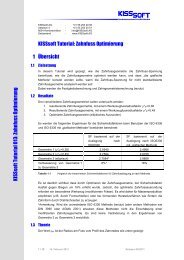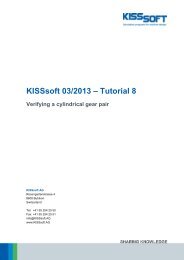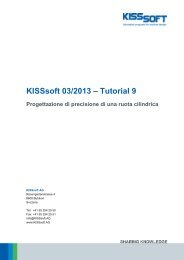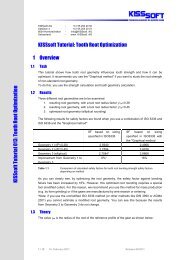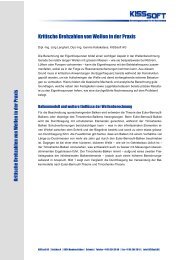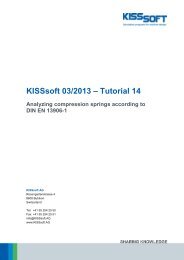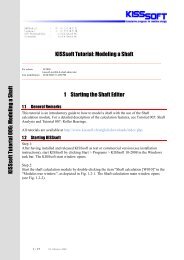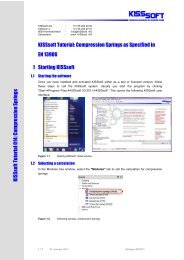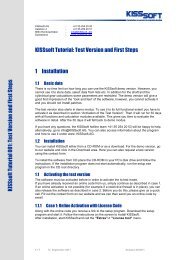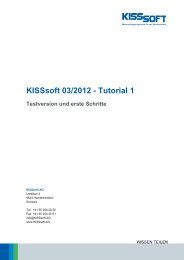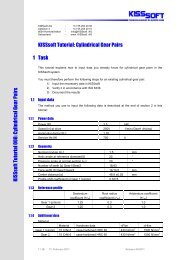KISSsoft Tutorial: Compression springs acc. EN 13906 1 Starting ...
KISSsoft Tutorial: Compression springs acc. EN 13906 1 Starting ...
KISSsoft Tutorial: Compression springs acc. EN 13906 1 Starting ...
Create successful ePaper yourself
Turn your PDF publications into a flip-book with our unique Google optimized e-Paper software.
<strong>KISSsoft</strong> <strong>Tutorial</strong>: <strong>Compression</strong> <strong>springs</strong> <strong>acc</strong>. <strong>EN</strong> <strong>13906</strong><br />
__________________________________________________________________________________________<br />
For Release 102008<br />
kisssoft-tut-014-E-compression-<strong>springs</strong>.doc<br />
Last modification 31/10/2008 08:36:00<br />
__________________________________________________________________________________________<br />
<strong>KISSsoft</strong> <strong>Tutorial</strong> 014: <strong>Compression</strong> <strong>springs</strong><br />
1.1 <strong>Starting</strong> the software<br />
1 <strong>Starting</strong> <strong>KISSsoft</strong><br />
Start <strong>KISSsoft</strong> using „Start/Program/<strong>KISSsoft</strong> 10-2008/<strong>KISSsoft</strong>“. The following window will<br />
appear:<br />
1.2 Select Calculation<br />
Figure 1.1-1: Start <strong>KISSsoft</strong>, <strong>KISSsoft</strong> main window.<br />
Using the Module tree window Tab “Modules”, select the compression <strong>springs</strong> calculation:<br />
Figure 1.2-1: Selecting compression <strong>springs</strong> calculation.<br />
1 / 6 2008-10-31
2.1 Task description<br />
2 Analysis of a compression <strong>springs</strong><br />
A cold formed compression <strong>springs</strong> 4 x 32 x 120 (material: spring-steel) should be dimensioned.<br />
Search for:<br />
Spring rate R<br />
Shear stress ô k2 at F 2 =300N<br />
Spring travel s h<br />
Afterwards the input of the following data is explained in this <strong>Tutorial</strong>:<br />
Wire diameter d<br />
4.0 mm<br />
coil diameter D<br />
40.0 mm<br />
Effective coil n<br />
12.5 mm<br />
Length of relaxes spring L 0<br />
235.0 mm<br />
Material<br />
Draht C (DIN 17223-1), untreated<br />
End of spring<br />
even<br />
Tolerances DIN 2095 quality standard 1<br />
Table 2.1-1: Geometry.<br />
Spring force F 1<br />
150 N<br />
Spring force F 2<br />
300 N<br />
Operating temperature 20.0 °C<br />
Stress<br />
dynamic<br />
Support<br />
fixed/ fixed<br />
2.2 Input of working data<br />
Table 2.1-2: Operating data.<br />
The operating data can be input, as below shown, directly in the input window, as an input of<br />
forces. The input of ways can be given alternatively.<br />
Figure 2.2-1: input window, area: ‚Working data’.<br />
The support kinds are shown in the help picture, which can be open with the „Info Button“ beside<br />
the support. The support coefficient í is used for the calculation of buckling travel s k . If the spring<br />
has not safe for buckling the spring will lead. The spring can buckle without support. If a leading is<br />
required a warning will be shown.<br />
Figure 2.2-2: Warning, the spring buckles and a leading is required.<br />
2 / 6
2.3 Input Geometry and material<br />
Figure 2.2-1: kind of supports and “support coefficient” í.<br />
<strong>KISSsoft</strong> offers in his data base a big choice of different compression <strong>springs</strong> <strong>acc</strong>ording to<br />
DIN 2098 supplementary sheet 1. The desired spring can be selected from the list directly. In our<br />
example we choose an available spring.<br />
Should the necessary spring not exist, the spring itself can be defined in the list by choice of „own<br />
input“. You find more exact instructions in this tutorial in addition below.<br />
To find a suitable spring in the list, we click before on the Button "Update …". The values<br />
dependent on the input, as for example spring travel, spring forces are thereby calculated etc. and<br />
are indicated. Afterwards an optimum choice can be selected.<br />
By a right mouse click in the select list of the spring you can be determined which values should be<br />
indicated.<br />
Figure 2.3-1: input window, area: ‚Geometry’ - choose of spring.<br />
The type of spring ends, as well as the manufacture and the tolerance will select below the table.<br />
Figure 2.3-2: choose of shown values by right mouse click.<br />
3 / 6
The material will be selected from a “Dropdown list” or will be defined over own input itself. By<br />
activating the flag in the "check box" for "shot-blasted" in the calculation will be considered that the<br />
wire is shot-blasted.<br />
2.4 Calculation<br />
Figure 2.3-3: choose the material.<br />
If all data are inputted, pressing in the Tool bar the icon “Ó” (or the button F5) in the main window<br />
the analysis will be started (see left marking in Figure 2.4-1) and the results will shown in the lower<br />
section of the main window. Note the status bar shows “Results are consistent” (see right marking<br />
in Figure 2.4-1).<br />
Figure 2.4-1: <strong>Starting</strong> the analysis and showing consistent results.<br />
In the results window is the appropriate spring rate R shown. In the graphics on the right side below<br />
the results are illustrated. There are a graphics for the force travel diagram and for the dynamic<br />
loads the Goodman- Diagram (if it not available, a diagram will approximate). To enlarge the<br />
graphics can be extracted by the button (right mark ) and scale up.<br />
4 / 6
Figure 2.4-2: Force-Travel Diagram.<br />
Using in the Tool bar the icon to the right of “”<br />
data, analysis parameters, and results is written.<br />
Name : Unnamed<br />
Changed by : ho on: 16.06.2008 at: 14:44:52<br />
Figure 2.4-3: Goodman Diagram.<br />
(or F6) a report containing all input<br />
<strong>Compression</strong> <strong>springs</strong> [F010]<br />
Calculation method: <strong>EN</strong> <strong>13906</strong>-1 (2002)<br />
INPUTS:<br />
Spring geometry<br />
Wire diameter (mm) [d] 4.000<br />
Tolerance analog to DIN 2076 C (mm) [Tol_d] 0.025<br />
Coil diameter (mm) [D] 40.000<br />
Inside diameter (mm) [Di] 36.000<br />
Outside diameter (mm) [De] 44.000<br />
Length of relaxes spring (mm) [L0] 235.000<br />
Effective coils [n] 12.500<br />
Stiff turns [nu] 2.000<br />
Total number of winds [nt] 14.500<br />
Ends of spring<br />
surface flattend<br />
Bearings coefficient 0.500<br />
Material<br />
Material Draht C (DIN 17223-1)<br />
Cold shaped<br />
Not shot peened<br />
Shearing modulus at 20°C (N/mm²) [G20] 81500.000<br />
Tensile strength (N/mm²) [Rm] 1726.000<br />
Shearing Modulus depending on temperature (1/°C) [alphaE] -0.00028<br />
load<br />
Lower spring force (N) [F1] 150.000<br />
Higher spring force (N) [F2] 300.000<br />
Operating temperature (°C) [TB] 20.000<br />
dynamic loading<br />
Results :<br />
Spring rate (N/mm) [R] 3.260<br />
Maximal usable length (mm) [Ln] 77.113<br />
Maximum spring travel (mm) [sn] 157.887<br />
Sum of minimal distance [Sa] 18.750<br />
Force for maximal spring-trave (N) [Fn] 514.713<br />
Block length (mm) [Lc] 58.363 (- 0.362)<br />
Shear stress at block length (N/mm²) [tauc] 916.475<br />
Permissible shear stress at block length (N/mm²) [tauc_zul] 967.000<br />
Stress coefficient [kappa] 1.135<br />
Shear stress [taukh] 270.994<br />
Permissible way stress (N/mm²) [taukh_zul] 321.103<br />
The spring is safe for buckling in the used range<br />
Spring travel for buckling (mm) [sk] 101.548<br />
Spring froce for buckling (N) [Fk] 331.047<br />
Shear modulus at service temperature (°C) [G] 81500.000<br />
Diameter increase (mm) [DeltaD] 0.698<br />
Eigen frequency (Hz) [fe] 72.548<br />
Mass (g) [mass] 181.184<br />
5 / 6
Load 1<br />
Spring force (N) [F1] 150.000<br />
Spring travel (mm) [s1] 46.012<br />
Spring length (mm) [L1] 188.988<br />
Shear stress (N/mm²) [tau1] 238.732<br />
Adjusted shear stress (N/mm²) [tau1k] 270.994<br />
Load 2<br />
Spring force (N) [F2] 300.000<br />
Spring travel (mm) [s2] 92.025<br />
Spring length (mm) [L2] 142.975<br />
Shear stress (N/mm²) [tau2] 477.465<br />
Adjusted shear stress (N/mm²) [tau2k] 541.987<br />
Utilization of shear stress (static) 0.494<br />
Utilization of shear stress (dynamic) 0.844<br />
Tolerances<br />
According to DIN 2095 quality standard<br />
1<br />
Permissible deviation from<br />
Coil diameter (mm) [AD] 0.300<br />
Lower spring force (N) [AF1] 11.700<br />
Higher spring force (N) [AF1] 13.100<br />
Spring length (mm) [AL0] 3.160<br />
Casing line (mm) [e1] 7.050<br />
Alignment (mm) [e2] 0.660<br />
2.5 Data for own inputs<br />
A special or not available spring will calculate by choosing „own input“ and the data for the spring<br />
will define oneself. Here it is also possible to determine the wire diameter and the effective coils<br />
with help of the spring rate (R = Ä fa / Ä s).<br />
Figure 2.5-1: Own input of spring geometry.<br />
Figure 2.5-2: Sizing of wire diameter.<br />
6 / 6



